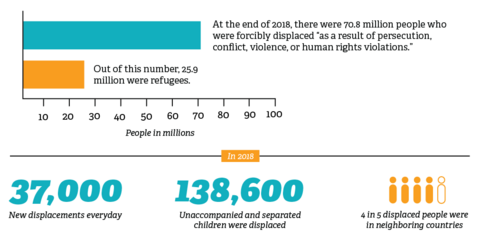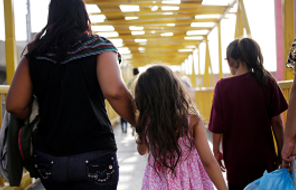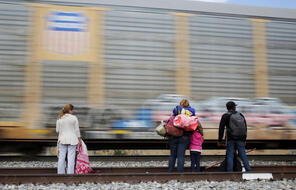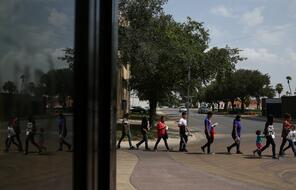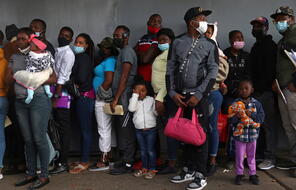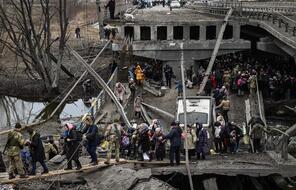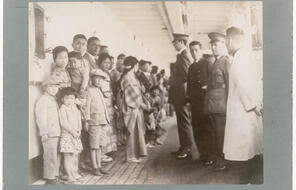What is Migration?
At a Glance
Language
English — USSubject
- History
- Social Studies
- Global Migration & Immigration
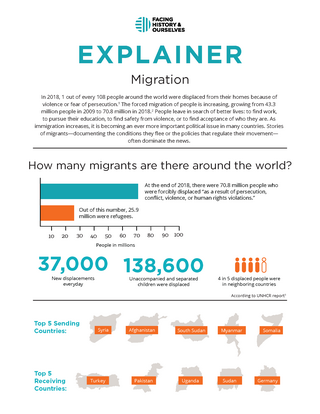
Explainer: Migration
Download a PDF of this resource for free
In 2018, 1 out of every 108 people around the world were displaced from their homes because of violence or fear of persecution. 1 The forced migration of people is increasing, growing from 43.3 million people in 2009 to 70.8 million in 2018. 2 People leave in search of better lives: to find work, to pursue their education, to find safety from violence, or to find acceptance of who they are. As immigration increases, it is becoming an ever more important political issue in many countries. Stories of migrants—documenting the conditions they flee or the policies that regulate their movement—often dominate the news.
This Explainer presents statistics on migration around the world and defines key terms relating to migration, such as “migrant,” “refugee,” and “asylum seeker,” in order to help you better understand events in the news.
- 1“Global Trends: Forced Displacement in 2018,” United Nations High Commissioner for Refugees (2019).
- 2“Global Trends,” United Nations High Commissioner for Refugees.
Who is a migrant?
A migrant is any person who moves away from their home residence, either inside a country or between countries. It is a broad term that encompasses both people who choose to leave and people, like refugees, who are forced to leave.
Who is a refugee?
In everyday language, the term refugee refers to “a person fleeing life-threatening conditions.” 1 Journalists often use refugee in this sense to refer to people fleeing from violence, economic devastation, or climate catastrophes, for example. However, the legal definition of refugee is more specific than the popular definition. According to the United Nations, a refugee is a person who is outside of their own country and will not or cannot return because of a “well-founded fear of being persecuted for reasons of race, religion, nationality, membership of a particular social group or political opinion.” 2 The definition also includes stateless people, who are not recognized as citizens of any country.
What is the difference between a refugee and an asylum seeker?
An asylum seeker is a person who is asking for protection under international law. All refugees begin as asylum seekers, but not all asylum seekers become refugees. Usually, an asylum seeker arrives in a foreign country and applies for protection under that country’s asylum laws. Each country has a different process for granting asylum. People applying for asylum are usually asked to supply evidence proving they have been persecuted along with their application. Under international law, people have the right to seek asylum in a different county if their own government fails in its obligations to them. Thus, asylum seekers migrate legally. 3
How has the definition of refugee changed over time?
1951 Convention on the Status of Refugees: The United Nations (UN) defined the term refugee and agreed on what rights refugees have, in this convention, which was passed in the aftermath of World War II. The Original UN definition of refugee only included Europeans.
1967 Protocol on the Status of Refugees: In this protocol, the UN expanded the definition of the term refugee to include people fleeing from any country around the world.
Who is considered to be a refugee under this definition?
-
A Syrian person who flees to Turkey because they fear they will be killed due to their political beliefs.
Why? Because this person left Syria, crossing an international border, and has a “well-founded fear of being persecuted” in Syria due to their political beliefs.
-
A Rohingya person from Myanmar, who is not able to get a Myanmar passport because only members of certain ethnic groups are able to gain citizenship.
Why? Because under international law everyone is entitled to a nationality and protections from a government. International law thus recognizes people without any citizenship as refugees.
-
An intersex person from Zimbabwe who flees the country after experiencing threats and violence because of their identity.
Why? Because the person was forced to flee their country, and the UN generally considers persecuted LBGTQI people “as members in a particular social group.”
Who is not considered to be a refugee under this definition?
-
A Syrian who flees from Damascus (the capital of Syria) to the Homs region of Syria because they fear they will be killed due to their political beliefs.
Why? Because even though they are forced to flee because of a “well-founded fear of being persecuted,” they did not leave Syria. A person must be outside of their country of origin to be considered a refugee.
-
A Bangladeshi person who is displaced because rising sea levels flood their home.
Why? Because international refugee law does not include people who are displaced due to natural disasters or climate change.
-
A Ghanain who cannot find any work to support their family and leaves Ghana to try to find work in another country.
Why? Because international refugee law does not include people who are forced to migrate for economic reasons.
- 1AE Shacknove, “Who Is a Refugee?,” Ethics 95 (1985): 274-284.
- 2“Convention and Protocol Relating to the Status of Refugees,” United Nations High Commissioner for Refugees.
- 3“Key Migration Terms,” IOM website.
Text version of migration facts used in infographic above:
According to a UNHCR Report: 1
- At the end of 2018, there were 70.8 million people who were forcibly displaced “as a result of persecution, conflict, violence, or human rights violations.”
- Out of this number, 25.9 million were refugees
- 37,000 new displacements every day
- 4 in 5 displaced people were in neighboring countries
- 138,600 unaccompanied and separated children were displaced in 2018
- Top five sending countries: Syria, Afghanistan, South Sudan, Myanmar, Somalia
- Top five receiving countries: Turkey, Pakistan, Uganda, Sudan, Germany
- Lebanon had the highest per capita number of refugees (1 in 6 people in Lebanon)
- Venezuela had a fast-growing number of refugees and asylum-seekers leaving the country in 2018
According to an IOM Report: 2
- Estimated 244 million international migrants in 2015.
- Internal migration (migration within a country) is difficult to measure, but there were an estimated 740 million in 2009.
- 1 “Global Trends,” United Nations High Commissioner for Refugees.
- 2“World Migration Report 2018,” International Organization for Migration (2017).

